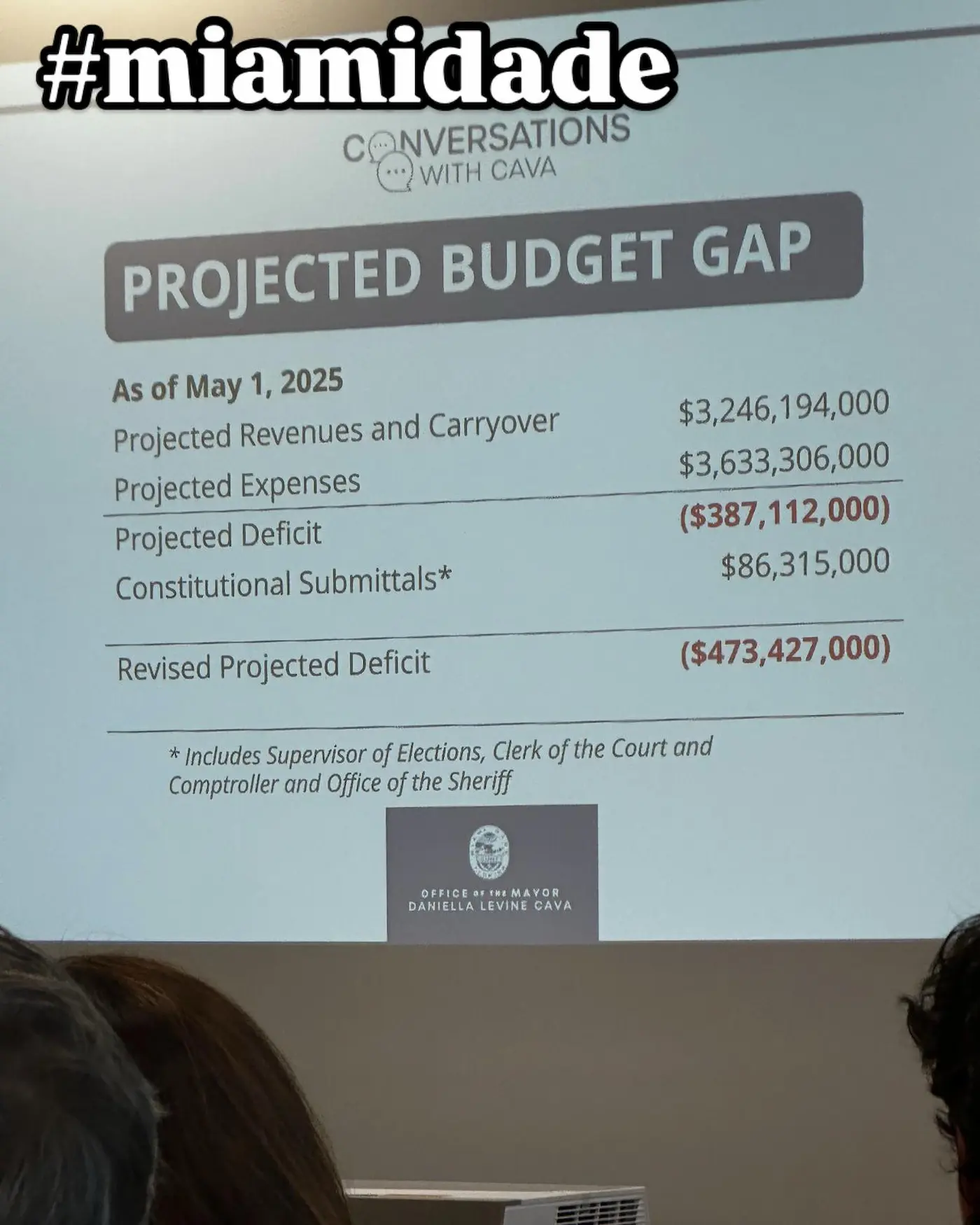|
Getting your Trinity Audio player ready... |
Tabla de Contenido/ Table of Contents
- 1 Daniella Levine Cava and the Mystery of the Billion-Dollar Budget 2025-2026: Who’s Lying? You Decide.
- 2 How much does 1 minute cost a taxpayer in Miami-Dade?
- 3 First question for Mayor Daniella Levine Cava:
- 4 Evidence vs. the Mayor’s Narrative:
- 5 Second question for Mayor Daniella Levine Cava:
- 6 What happens if property taxes disappear?
- 7 How to Participate in the Budget Process?
- 8 The Mayor’s Response and the People’s Judgment:
Daniella Levine Cava and the Mystery of the Billion-Dollar Budget 2025-2026: Who’s Lying? You Decide.
Miami-Dade County Proposed Budget FY 2025-26: What You Need to Know
Miami-Dade County has begun the process of developing its Proposed Budget for Fiscal Year 2025-26, which will define how public resources will be used for services, infrastructure, personnel, technology, housing, transportation, security, and more.
Over the next few months, public meetings will be held throughout the county to discuss:
- Proposed tax rates (including property taxes)
- Changes to fees and charges for services
- Strategic priorities for the next fiscal year
You can watch all meetings via live webcast.
- 🧾 Stages of the Budget Process:
Planning and Initial Submission: - Budget Submission Manual
- Instructions for preparing departmental plans
- Technical Support Tools:
- Span of Control Analysis (Excel)
- Relief Factor Calculation (Excel)
- Five-Year Vehicle Replacement Plan (Excel)
- Applicable Financial and Technical Parameters:
- Staffing Assumptions and Applicable Rates
- Administrative Reimbursement Rate
- Internal Services Department (ISD) Rates
- Communications and Customer Service Department (CCED) Rates
- Regulation and Economic Resources Department (RER) Assumptions
- Information Technology Department (ITD) Manual
- IT Business Case Narrative
- CIIP Salary Reimbursement Projection Template Administrative
- General Guidelines for Capital Investments:
- Guide for Bondable Capital Improvements
Since Daniella Levine Cava took office as Mayor of Miami-Dade County in November 2020, the county’s total annual budget has grown exponentially—from $8.909 billion in fiscal year 2019-20 to $12.759 billion in fiscal year 2024-25. Likewise, the operating budget has increased from $5.675 billion to more than $8.072 billion, and the total number of public employees has grown substantially, from 28,409 to 31,252.
In light of these official—public and verifiable—figures, it is baffling that in various public appearances, the mayor refrains from detailing these clear accounts. Instead, she resorts to vague, simplistic, and financially shallow speeches—more fitting for elementary school classrooms than for informed adult taxpayers. As if the residents of this county were incapable of understanding how their taxes are being spent.

How much does 1 minute cost a taxpayer in Miami-Dade?
How can we solve the problems in Miami-Dade and its cities if our elected officials limit public speaking time to 1 minute in the County and 3 minutes in cities like Hialeah? What is the point of the “right to participate” if responses are evasive, repetitive, or just political theater? If they don’t listen to us—if our questions are swept away like dust—then who is truly defending the people’s interests?
Democracy is not a monologue. It’s a dialogue. And if we are silenced, change will never come.
First question for Mayor Daniella Levine Cava:
Since Daniella Levine Cava took office as Mayor of Miami-Dade County in November 2020, the total annual budget has grown exponentially—from $8.909 billion in FY 2019-20 to $12.759 billion in FY 2024-25. Meanwhile, the operating budget rose from $5.675 billion to $8.072 billion in the same period. Likewise, the total number of employees increased from 28,409 to 31,252, with a substantial rise in total salary spending—from $5.675 billion to $8.072 billion.
Given this obvious budgetary expansion:
How is it possible that the mayor and the 13 County Commissioners claim there aren’t enough resources to stop the mass death of animals in county shelters due to institutional neglect… to fix the unacceptable conditions at Miami International Airport… to effectively protect over 900 evicted families in Sweetwater—a process that resulted in four deaths—or to support essential organizations like Circle of Brotherhood that work to reduce violence in underserved communities?
Where exactly has this massive increase in funding gone, if the County continues to prioritize decorative lighted bridges over decent housing, finance luxury events nearly every day, and allow taxpayers to cover the overpricing of so-called “affordable” housing built on public land?
Evidence vs. the Mayor’s Narrative:
1. Animal shelters and institutional neglect
The mayor claims “everything is fine,” yet reality shows shelters in deplorable conditions—with thousands of dogs and cats dying due to medical negligence and administrative abandonment. Public complaints, backed by video evidence and direct testimony from volunteers and activists, completely contradict the official County narrative.
2. Miami International Airport
Despite receiving one of the largest budgets in history, the airport continues to deteriorate, facing constant complaints from travelers and residents alike. Promised improvements have been superficial or nonexistent. Leadership remains unchanged, despite clear signs of chronic inefficiency.
3. The Sweetwater tragedy and mass eviction
While the mayor speaks of solidarity and family support, more than 900 families were evicted in Sweetwater—an operation that ended in tragedy with the death of four people, including vulnerable seniors. Where was the multi-billion-dollar budget when hundreds of families needed real, effective protection?
4. Circle of Brotherhood and community safety
As the budget keeps growing, organizations like Circle of Brotherhood—which have shown real results in reducing violence in vulnerable neighborhoods—continue to be ignored. Meanwhile, the County funds luxury events almost daily, while real safety and community support remain neglected.
5. Decorative bridges vs. decent housing
Millions of dollars have been spent on decorative projects—like lighted bridges—while thousands of residents still lack dignified housing. Public lands are being used for “affordable” housing projects whose final costs are passed on to taxpayers.
Second question for Mayor Daniella Levine Cava:
Considering that 37% of Miami-Dade County’s operating budget—over $2.419 billion in FY 2022-23—comes directly from property taxes,
what will happen to essential public services if this vital source of funding disappears, as allegedly planned by the federal government?
Even with this money currently available, we already see clear examples of waste, lack of oversight, and administrative negligence in key areas—like animal shelters, the dismal condition of the airport, overpriced “affordable” housing, and the lack of support for vital community safety programs.
So then, where will the money come from to sustain the recently approved legislation that grants officials pay raises and guarantees lifetime pensions to “recyclable politicians”?
And in light of this alarming fiscal scenario,
how does Mayor Daniella Levine Cava plan to manage the real arrival of the DOGE (Department of Government Efficiency) in Miami-Dade—not just the flashy Instagram announcements—when public funds have already been wasted on creating dubious “efficiency” departments led by former political rivals whose management raises serious ethical concerns and internal red flags that could draw state and federal scrutiny?
What happens if property taxes disappear?
As of now, 37% of Miami-Dade’s operating budget comes directly from property taxes ($2.419 billion in FY 2022-23). If, as some allege, the federal government eliminates these taxes, where will the money come from to fund the ever-growing bureaucracy, rising salaries, and lifetime pensions recently approved by and for public officials?
This future scenario is especially concerning, given the County’s ongoing trends of wasteful spending, weak oversight, and the creation of “efficiency” departments run by political figures with questionable backgrounds. In this context, how does Mayor Levine Cava plan to implement the true DOGE—beyond social media stunts?
How to Participate in the Budget Process?
✅ Attend public meetings.
✅ Review available documents to understand how the budget is calculated and executed.
✅ Send your comments and proposals to your commissioner or the Department of Budget and Management (OMB).
Transparency and Citizen Oversight
The 2025-26 budget is being drafted, and your participation is essential to ensure that County funds are used efficiently, equitably, and for the benefit of all residents.
🔍 Get informed.
🗣️ Participate.
🧾 Demand accountability.
For more information and access to all documents, visit the County’s official website or contact the Office of Management and Budget (OMB) directly.
The Mayor’s Response and the People’s Judgment:
In the face of these valid concerns and official data, Mayor Daniella Levine Cava has publicly claimed that these criticisms are false—suggesting that social media and independent media that ask uncomfortable questions are merely deceiving the public.
But official evidence, public testimony, and the budget figures say otherwise.
Now it’s up to you, the citizen, to review these facts and numbers.
Who’s really lying?
The mayor has the microphone,
but you have the vote—and the right to demand real transparency and results.







